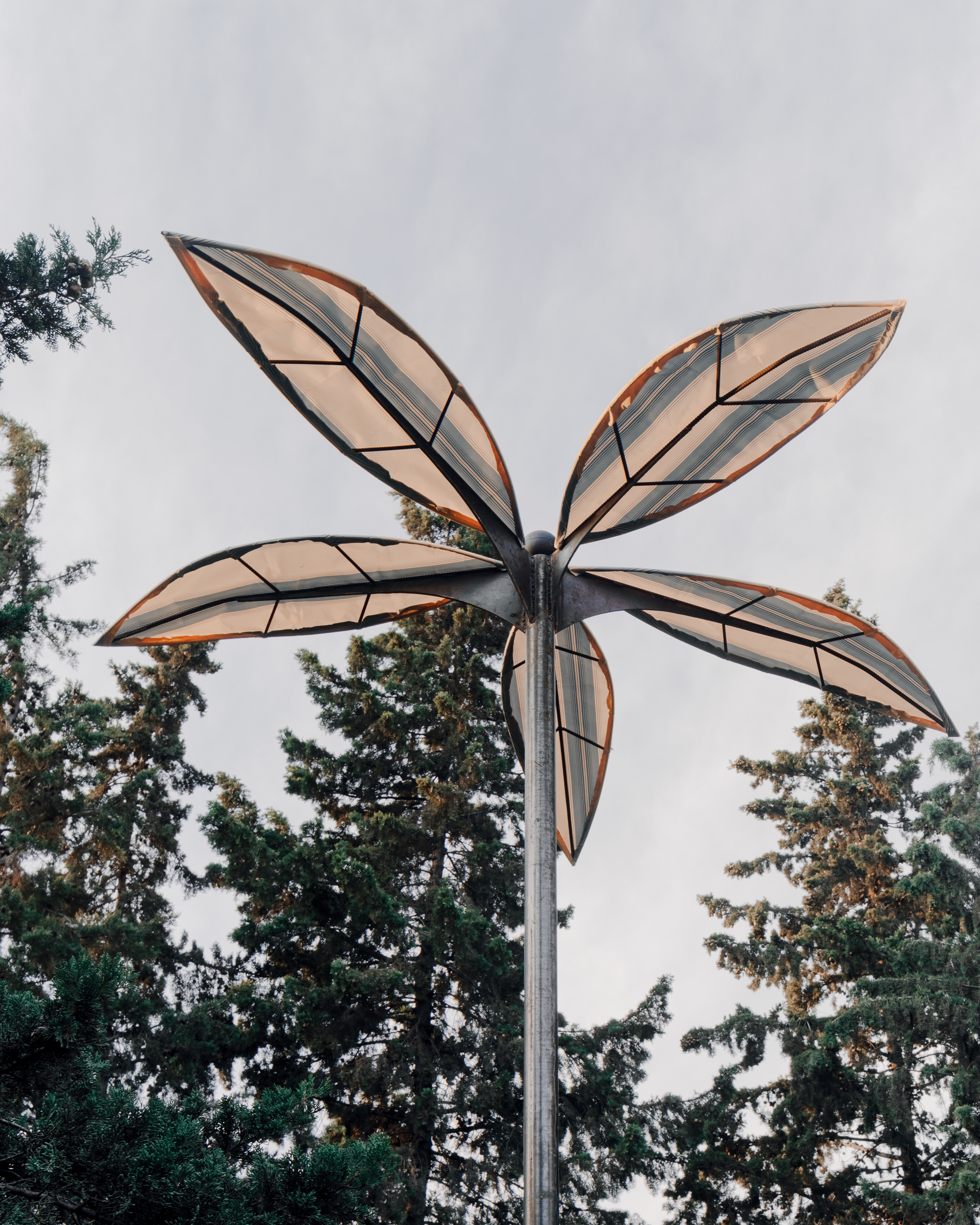= More info =

Nato Bagrationi, Flowers are for All, Gldani, Al. Gobronidze no.1
Public Art Fund Project Flowers Are for All - Installation by Nato Bagrationi
December 2023
Text: Vija Skangale
“Dancing in the wind, kissing the sun, under the sky, blue and bright, they whisper life's tales day and night.”[1]
How does the close proximity between the urban periphery and nature influence one another? What happens when the artist attempts to dissolve the boundaries between dichotomic notions of “urban” and “nature” blur and create a new utopian reality? These complex questions can be explored in the project Flowers Are for All, which opens on 17th December in Tbilisi, Georgia. Twenty-two-meter-high flowers will be “planted” in Gldani, the outskirts of Tbilisi, which is considered a micro-town on its own[2] with its own identity. Gldani’s “fields” of grey high-rise apartment blocks were built between 1969 and 1980[3] as part of an industrialisation project and expanding the Soviet programme to bring the low-cost concrete panelled blocs across the country. The Gldani project, designed by Temur Bochorishvli, stands as a massive housing district located on the northern fringes of Tbilisi and is intended to house 147,000 residents. Built on the land previously owned by a neighbouring village bearing the same name, Gldani, to this day, remains the largest housing project in Tbilisi, encompassing eight distinct microregions known as “micro rayons” within its confines. Furthermore, Gldanula, meaning “small Gldani” in Georgian, another creation of Bochorishvili, has emerged to the north. Despite its smaller scale compared to Gldani, Gldanula holds its significance within the evolving urban framework of the region.
The prefabricated mass estates and almost identical blocs can be seen across many post-soviet countries. Still, there are the local ecologies that developed after the collapse of the Soviet Union that define Gldani from any other similar districts.
Nato Bagrationi, an architecture graduate from Tbilisi State Academy of Arts, explores the microcosms specific to Gldani. After the collapse of the Soviet Union in the 1990s, when privatisation became possible, the local shops, so-called “budkas” (booths) trading various products, started popping up in the Georgian capital, Tbilisi. The manufactured structures, stalls and flamboyant tents clustered around the Akhmeteli metro and became an integral facet of the local scenery. The colourful umbrellas and tents (figure #1) contrasting against the monotonous, uniformed grey Soviet blocksused as protective shelters for traders against weather conditions such as the scorching summer sun or rain, become a starting point for Nato and inspiration to create gigantic flowers that would be placed on the little island in the busy roundabout.

Figure #1.
The aerial video footage of this place (figure #2) posted by the Tbilisi Public Art Fund on social media shows vehicles' heavy, chaotic movement. The island is big enough to host a twenty-flower installation built with a rustic-looking iron armature commonly used in construction. Its petals are covered in the fabric Gldani traders use in the nearby open-air market. The array of colourfully patterned flowers and their widespread petals could be seen as shelters for passers-by, just like colourful umbrellas for the market traders. However, in its broadest sense, Nato sees shelters as places that provide protection from danger; shelters can take many forms, from natural structures such as caves to man-made structures such as houses or apartments. While the flower installation cannot provide a real-life shelter, it bears a symbolic meaning. It plays on the dualistic notions of shelter: artificial shelter as a means of security and protection, but also nature being the escape and shelter from urban living.

Figure #2.
The roundabout island has four intersecting paths intended for pedestrians. However, due to the absence of marked pedestrian crossings in this bustling roundabout, it remains unclear how pedestrians can safely navigate and reach the island amidst the heavy traffic.
The installation Flowers Are for All is set to stay in place for six months, during which the artist anticipates that “her” flowers will organically integrate into the local environment, vulnerable to the exposure of its surroundings. Most certainly, the high-density traffic and pollution around these urban flowers will gradually coat them in thick layers of grey dust, and exposure to the sun will cause their vibrant colours to fade in the coming months.

Nato Bagrationi, Flowers are for All, detail
Consequently, the metal structure of the flowers will also take on a more weathered appearance and acquire the rust that would make it look more suited to the shabby, grey Soviet urban environments. This intervention will assimilate into this landscape, becoming an intrinsic part of the bustling metropolitan scene, deeply woven into the densely populated scenery. The artist takes the delicate nature of flowers and transforms them into robust urban elements capable of withstanding harsh environments and developing resilience.
While this time, Tbilisi-based artist attempts to bring nature into the urban jungles, in her earlier projects, she often explored the harmful impact of humans on nature. One of her works, Red Ground (figure #3) during the Garikula residency, entailed draping hillsides with thousands of red strings. These recurring lines, stretching from top to bottom, formed a bleeding, man-like cut exposing the almost humanlike flesh of the earth and its energy. The striking red colour, contrasted with the surrounding greenery, draws attention to the silent, hidden pain inflicted by humans on nature, but with the energy shining through the open wound.
The theme of ecology is seen in her other piece titled Poisoned Ground (figure #4), emphasised by featuring the toxic-looking pink circles on the grass.
Figure #3. Figure #4.

Figure #5.
Intersecting with Nato’s architectural background, the Two Pieces of Soil (figure #5), the installation of perfectly cut-out pieces of land with the greenery at the top being installed inside the white cube as part of the Oxygen Biennial in 2019 refers to the natural landscape being destroyed and filled with ugly high-rise buildings in Tbilisi, leaving no space for nature or parks which is a major concern for the locals. The standalone pieces in the gallery face the window into nature, where they were part of it once, but now they are disjointed and distanced from each other.
While it is close to impossible to define the relationship between urban periphery and nature, we are left with just speculations that there is no centre and periphery, inequality, or privilege in nature. The project Flowers Are for All envisions the urban environment as inclusive and integrated as nature. Gldani was designed to house people from Tbilisi and other rural areas of Georgia, offering accommodation to those relocating from different regions. To quote Tinatin Gurgenidze, “Some refer to Gldani as a ghetto, others say that it is like the “Bronx", in view of its diversity’[4] and it is not the first to host contemporary interventions.”[5] The unity of the chain of interlinked structures is practical, yet it signifies the reproductive cycle of life of nature and life. In this project, the flower's poetical fragility and beauty features evolved into resilient structures, yet buoyant and hopeful for a better change for the local communities.
While the Tbilisi Public Art Fund aims to make contemporary art accessible to a broader audience, meanwhile, Nato Bagrationi's multifaceted body of work strives to construct a utopian urban environment through her latest installation, Flowers Are for All. This symbol of protection and sanctuary explores the delicate issue of the environmental impact of urban living in post-Soviet industrialised regions like Gldani, where the local ecosystem faces considerable challenges.
_1.jpg)
Nato Bagrationi, Flowers are for All, detail
Vija Skangale
Vija Skangale is a Georgia-born, London-based multidisciplinary educator, curator, and researcher. She is currently a PhD candidate and a visiting lecturer at Central Saint Martins, University of the Arts, London. She participated in various art projects including the Kunsthalle Tbilisi, Tate Modern Late, Tate Exchange among others. Her written work has been featured in publications such as MoMA, Biennial Foundation magazine, the Calvert Journal, Tbilisi Public Art Fund, and many others. Her research focuses on recent histories of contemporary art within the framework of post-socialist transition. She explores practices and exhibition histories in Georgia that have been under-documented, aiming to broaden our understanding of exhibition-making during a period of significant cultural transformation.
[1] Excerpt from Nato Bagrationi’s proposal.
[2] https://danarti.org/en/article/standardized-lives----tinatin-gurgenidze/69
[3] Gogishvili, David. (2024). Gldani - From ambitious experimental project to half-realised Soviet mass-housing district in Tbilisi, Georgia. 10.4324/9781003327592-15.
[4] https://danarti.org/en/article/standardized-lives----tinatin-gurgenidze/69
[5] In the 2018 Tbilisi Architecture Biennial had projects exploring the Gldani district. https://www.dezeen.com/2019/01/09/tbilisi-architecture-biennial-installations/








